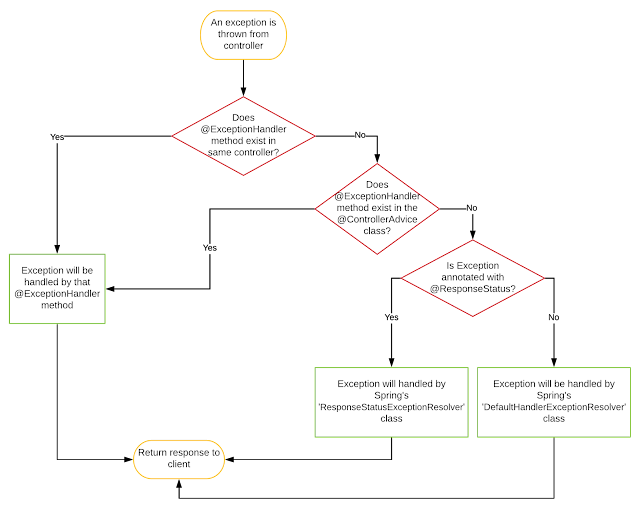Giriş
Exception döndürmek için 3 yöntem var
Exception döndürmek için 3 yöntem var
- @ControllerAdvice + @ExceptionHandler : Global Exception handling yapar- Using HandlerExceptionResolver- Using ResponseStatusException
JSON döndüren REST noktası exception fırlatırsa, exception'ı içeren JSON döndürebilmeyi sağlar. Bu sınıfın kardeşi @ControllerAdvice anotasyonu. Açıklaması şöyle. Yani bu anotasyon yerine @ControllerAdvice kullanılabilir
Kullanım
@RestControllerAdvice is just a syntactic sugar for @ControllerAdvice + @ResponseBody ...
Kullanım
Şeklen şöyle
1. Metodumuz @ExceptionHandler(...) anotasyonuyla işaretlenir. Böylece servis sınıfı bu exception'ı fırlatırsa ilgili metod tetiklenir.
2. Genellikle kendi tanımladığımız bir exception sınıfı ResponseEntity ile sarmalanır ve ResponseEntity döndürülür.
3. ResponseEntity döndürmek yerine Metodumun üzerine @ResponseStatus anotasyonu eklersem de olur
4. Sınıfım ResponseEntityExceptionHandler sınıfından kalıtabilir. Böylece gerekirse Spring tarafından hazırlanan ResponseEntity gerekirse override edilebilir.
Ben kendi kullanımımda
org.springframework.dao.InvalidDataAccessResourceUsageException'ları yakaladım
1. Exception'ı Decorate Etmek
org.springframework.dao.InvalidDataAccessResourceUsageException'ları yakaladım
1. Exception'ı Decorate Etmek
Bazı kodlarda şöyle yapılıyor. Yani @ResponseStatus kullanılarak veya exception ResponseStatusException'dan kalıtarak bir HTTP sonucu ile exception ilişkilendiriliyor. Ancak bence bu doğru değil. Çünkü exception ve HTTP kodları farklı şeyler.
@ResponseStatus(value = HttpStatus.NOT_FOUND)public class NoSuchElementFoundException extends RuntimeException {...}
veya şöyle yapılıyor. ResponseStatusException yazısına bakabilirsiniz
public class NoSuchElementFoundException extends ResponseStatusException {public NoSuchElementFoundException(String message){super(HttpStatus.NOT_FOUND, message);}@Overridepublic HttpHeaders getResponseHeaders() {// return response headers}}
ResponseEntity Döndürmek
Ben bu yöntemi çok kısıtlı bilgi döndürdüğü için tercih etmiyorum
Örnek
Şöyle yaparız
Şöyle yaparız.
@ResponseStatus Kullanmak
Örnek
Şöyle yaparız
@RestControllerAdvice
public class ExceptionAdvice {
@ExceptionHandler(value = NotFoundException.class)
public ResponseEntity<CustomErrorResponse> handleException(NotFoundException e) {
CustomErrorResponse err = new CustomErrorResponse("NOT_FOUND_ERROR", e.getMessage());
err.setTimestamp(LocalDateTime.now());
err.setStatus((HttpStatus.NOT_FOUND.value()));
return new ResponseEntity<>(error, HttpStatus.NOT_FOUND);
}
}
Şöyle yaparız.
@RestControllerAdvice
public class GlobalExceptionHandler {
@ExceptionHandler(value = {Exception.class})
public ResponseEntity<ExceptionResponse> unknownException(Exception ex) {
Foo resp = new Foo (ex, level); // my custom response object
return new ResponseEntity<ExceptionResponse>(resp, resp.getStatus());
}
}Örnek
Şöyle yaparız
@ExceptionHandler(NoSuchElementFoundException.class)public ResponseEntity<String> handleNoSuchElementFoundException(NoSuchElementFoundException exception) {return ResponseEntity.status(HttpStatus.NOT_FOUND).body(exception.getMessage());}
Bu yöntem bence en iyisi. Düzgün bir CustomErrorReponse nesnesi tanımlanırsa bayağı detaylı bilgi dönülebilir.
Örnek
Şöyle yaparız.
@ResponseBody@ResponseStatus(HttpStatus.INTERNAL_SERVER_ERROR)@ExceptionHandler(Exception.class)public CustomErrorResponse handle(Exception e) {return new CustomErrorResponse(e.getMessage());}

Hiç yorum yok:
Yorum Gönder